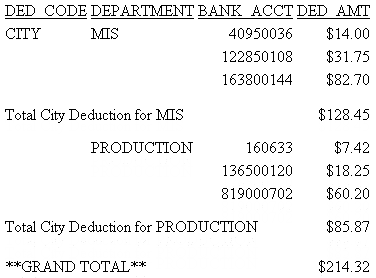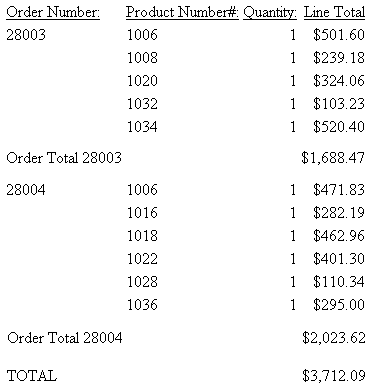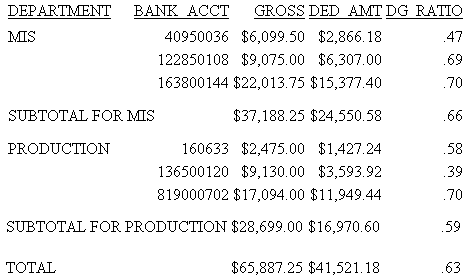How to: |
A label for a row or column total identifies the sum of values for two or more fields. A label draws attention to the total. It is particularly important that you create a label for a row or column total if you have both in one report.
For related information, see Including Totals and Subtotals.
fieldname [AND] ROW-TOTAL[/justification][/format] [AS 'label'] fieldname [AND] COLUMN-TOTAL[/justification] [AS 'label']
or
fieldname [AND] COLUMN-TOTAL[/justification] [AS 'label']
where:
- fieldname
- Is a field named in a display command.
- justification
- Is the alignment of the label. Valid values are:
L which left justifies the label.
R which right justifies the label.
C which centers the label.
For related information, see Justifying a Label for a Row or Column Total.
- format
- Is the format of the row or column total. When fields with the same format are summed, the format of the total is the same as the format of the fields. When fields with different formats are summed, the default D12.2 is used for either the row or column total.
- label
- Is the customized row or column total label. The default label is TOTAL.
You can also specify a row or column total with the ON TABLE phrase. With this syntax, you cannot include field names with ROW-TOTAL. Field names are optional with COLUMN-TOTAL.
ON TABLE ROW-TOTAL[/justification][/format] [AS 'label'] ON TABLE COLUMN-TOTAL[/justification] [AS 'label'] [fieldname fieldname fieldname]
If a request queries a field created with COMPUTE, the value of that field is included in a row or column total. Keep that in mind when customizing a label that identifies the total.
This request creates the label Total Population by State for the row total, and the label Total Population by Gender for the column total. The format D12 for ROW-TOTAL displays that data with commas.
TABLE FILE GGDEMOG PRINT MALEPOP98 FEMPOP98 ROW-TOTAL/D12 AS 'Total Population by State' BY ST WHERE (ST EQ 'WY' OR 'MT') ON TABLE COLUMN-TOTAL AS 'Total Population by Gender' ON TABLE SET PAGE-NUM OFF ON TABLE SET ONLINE-FMT HTML ON TABLE SET STYLESHEET * TYPE=REPORT, GRID=OFF, $ ENDSTYLE END
The output is:

This request adds the populations of two states, sorts the information using the ACROSS phrase, and labels the row totals as Total by Gender. There are two row totals within the Total by Gender column, Male Population and Female Population.
TABLE FILE GGDEMOG
SUM MALEPOP98/D12 FEMPOP98/D12
ROW-TOTAL AS 'Total by Gender'
ACROSS ST
WHERE ST EQ 'WY' OR 'MT';
ON TABLE SET PAGE-NUM OFF
ON TABLE SET ONLINE-FMT HTML
ON TABLE SET STYLESHEET *
TYPE=REPORT, GRID=OFF, $
ENDSTYLE
ENDThe output is:



